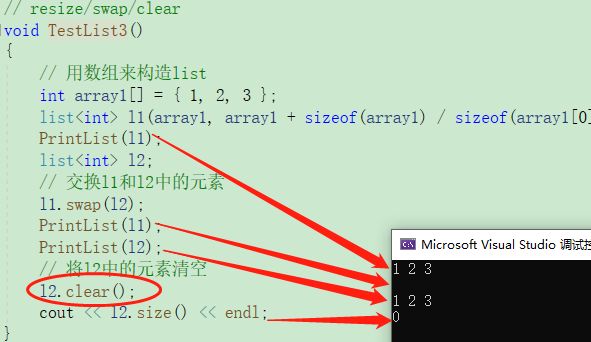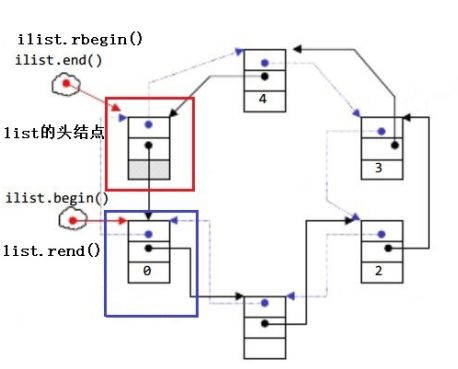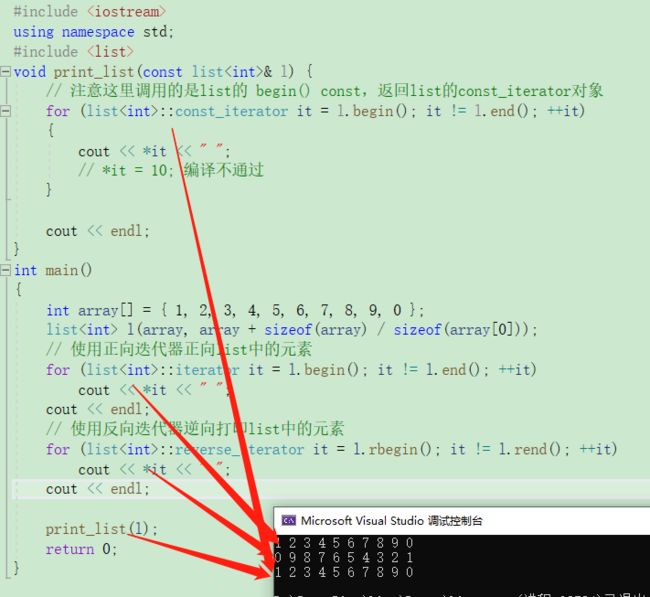C++--list的使用和模拟实现
文章目录
- 前言
- 一、list的介绍及使用
-
- 1.1 list的介绍
- 1.2 list的使用
-
- 1.2.1 list的构造
- 1.2.2 list iterator的使用
- 1.2.3 list capacity
- 1.2.4 list element access
- 1.2.5 list modifiers
- 1.2.6 list的迭代器失效
- 二、list的模拟实现
-
- 2.1 模拟实现list
- 2.2对模拟的rose::list进行测试
- 三、list与vector的对比
- 总结
前言
今天我们学的是C++的STL容器中的list,是一个双向的带头的链表,在任意位置的插入和删除的时间复杂度为O(1),今天我们首先结合C++中list文档了解关于list容器的函数接口来实现链表的增删查改等内容,到文章最后我们自己也来模拟实现list容器。
正文开始
一、list的介绍及使用
1.1 list的介绍
list的文档介绍
- list是可以在常数范围内在任意位置进行插入和删除的序列式容器,并且该容器可以前后双向迭代。
- list的底层是双向链表结构,双向链表中每个元素存储在互不相关的独立节点中,在节点中通过指针指向
其前一个元素和后一个元素。- list与forward_list非常相似:最主要的不同在于forward_list是单链表,只能朝前迭代,已让其更简单高
效。(forward后面在了解,就是一个单链表)- 与其他的序列式容器相比(array,vector,deque),list通常在任意位置进行插入、移除元素的执行效率
更好。- 与其他序列式容器相比,list和forward_list最大的缺陷是不支持任意位置的随机访问,比如:要访问list
的第6个元素,必须从已知的位置(比如头部或者尾部)迭代到该位置,在这段位置上迭代需要线性的时间
开销;list还需要一些额外的空间,以保存每个节点的相关联信息(对于存储类型较小元素的大list来说这
可能是一个重要的因素)
1.2 list的使用
list中的接口比较多,此处类似,只需要掌握如何正确的使用,然后再去深入研究背后的原理,已达到可扩展
的能力。以下为list中一些常见的重要接口
1.2.1 list的构造
| 构造函数( (constructor)) | 接口说明 |
|---|---|
| list() | 构造空的list |
| list (size_type n, const value_type& val = value_type()) | 构造的list中包含n个值为val的元素 |
| list (const list& x) | 拷贝构造函数 |
| list (InputIterator first, InputIterator last) 用[first, last) | 区间中的元素构造list |
// constructing lists
#include
int main()
{
std::list<int> l1; // 构造空的l1
std::list<int> l2(4, 100); // l2中放4个值为100的元素
std::list<int> l3(l2.begin(), l2.end()); // 用l2的[begin(), end())左闭右开的区间构造l3
std::list<int> l4(l3); // 用l3拷贝构造l4
// 以数组为迭代器区间构造l5
int array[] = { 16,2,77,29 };
std::list<int> l5(array, array + sizeof(array) / sizeof(int));
// 用迭代器方式打印l5中的元素
for (std::list<int>::iterator it = l5.begin(); it != l5.end(); it++)
std::cout << *it << " ";
std::cout << endl;
// C++11范围for的方式遍历
for (auto& e : l5)
std::cout << e << " ";
std::cout << endl;
return 0;
}
1.2.2 list iterator的使用
| 函数声明 | 接口说明 |
|---|---|
| begin + end | 返回第一个元素的迭代器+返回最后一个元素下一个位置的迭代器 |
| rbegin + rend | 返回第一个元素的reverse_iterator,即end位置,返回最后一个元素下一个位置的reverse_iterator,即begin位置 |
【注意】
- begin与end为正向迭代器,对迭代器执行++操作,迭代器向后移动
- rbegin(end)与rend(begin)为反向迭代器,对迭代器执行++操作,迭代器向前移动
1.2.3 list capacity
| 函数声明 | 接口说明 |
|---|---|
| empty | 检测list是否为空,是返回true,否则返回false |
| size | 返回list中有效节点的个数 |
1.2.4 list element access
| 函数声明 | 接口说明 |
|---|---|
| front | 返回list的第一个节点中值的引用 |
| back | 返回list的最后一个节点中值的引用 |
1.2.5 list modifiers
| 函数声明 | 接口说明 |
|---|---|
| push_front | 在list首元素前插入值为val的元素 |
| pop_front | 删除list中第一个元素 |
| push_back | 在list尾部插入值为val的元素 |
| pop_back | 删除list中最后一个元素 |
| insert | 在list position 位置中插入值为val的元素 |
| erase | 删除list position位置的元素 |
| swap | 交换两个list中的元素 |
| clear | 清空list中的有效元素 |
#include
using namespace std;
void PrintList(list<int>& l) {
for (auto& e : l)
cout << e << " ";
cout << endl;
}
//=====================================================================================
// push_back/pop_back/push_front/pop_front
void TestList1()
{
int array[] = { 1, 2, 3 };
list<int> L(array, array + sizeof(array) / sizeof(array[0]));
// 在list的尾部插入4,头部插入0
L.push_back(4);
L.push_front(0);
PrintList(L);
// 删除list尾部节点和头部节点
L.pop_back();
L.pop_front();
PrintList(L);
}
//=====================================================================================
// insert /erase
void TestList2()
{
int array1[] = { 1, 2, 3 };
list<int> L(array1, array1 + sizeof(array1) / sizeof(array1[0]));
// 获取链表中第二个节点
auto pos = ++L.begin();
cout << *pos << endl;
// 在pos前插入值为4的元素
L.insert(pos, 4);
PrintList(L);
// 在pos前插入5个值为5的元素
L.insert(pos, 5, 5);
PrintList(L);
// 在pos前插入[v.begin(), v.end)区间中的元素
vector<int> v{ 7, 8, 9 };
L.insert(pos, v.begin(), v.end());
PrintList(L);
// 删除pos位置上的元素
L.erase(pos);
PrintList(L);
// 删除list中[begin, end)区间中的元素,即删除list中的所有元素
L.erase(L.begin(), L.end());
PrintList(L);
}
// resize/swap/clear
void TestList3()
{
// 用数组来构造list
int array1[] = { 1, 2, 3 };
list<int> l1(array1, array1 + sizeof(array1) / sizeof(array1[0]));
PrintList(l1);
list<int> l2;
// 交换l1和l2中的元素
l1.swap(l2);
PrintList(l1);
PrintList(l2);
// 将l2中的元素清空
l2.clear();
cout << l2.size() << endl;
}
int main()
{
TestList1();
//TestList2();
//TestList3();
return 0;
}


list中还有一些操作,需要用到时大家可参阅list的文档说明
1.2.6 list的迭代器失效
前面说过,此处大家可将迭代器暂时理解成类似于指针,迭代器失效即迭代器所指向的节点的无效,即该节
点被删除了。因为list的底层结构为带头结点的双向循环链表,因此在list中进行插入时是不会导致list的迭代
器失效的,只有在删除时才会失效,并且失效的只是指向被删除节点的迭代器,其他迭代器不会受到影响。
void TestListIterator1()
{
int array[] = { 1, 2, 3, 4, 5, 6, 7, 8, 9, 0 };
list<int> l(array, array + sizeof(array) / sizeof(array[0]));
auto it = l.begin();
while (it != l.end())
{
// erase()函数执行后,it所指向的节点已被删除,因此it无效,在下一次使用it时,必须先给其赋值
l.erase(it);
++it;
}
}
// 改正
void TestListIterator()
{
int array[] = { 1, 2, 3, 4, 5, 6, 7, 8, 9, 0 };
list<int> l(array, array + sizeof(array) / sizeof(array[0]));
auto it = l.begin();
while (it != l.end())
{
l.erase(it++); // it = l.erase(it);
}
}
二、list的模拟实现
2.1 模拟实现list
要模拟实现list,必须要熟悉list的底层结构以及其接口的含义,通过上面的学习,这些内容已基本掌握,现
在我们来模拟实现list。
namespace rose
{
template<class T>
struct _list_node
{
T _val;
_list_node<T>* _prev;
_list_node<T>* _next;
_list_node(const T& val=T())
:_val(val)
,_prev(nullptr)
, _next(nullptr)
{}
};
//原生指针(节点指针),已经无法完成迭代器的功能
//list::iterator ->Node*
//通过两个模板参数控制
template<class T,class Ref,class Ptr>
struct _list_iterator //_list_iterator去封装Node*,重载这个类的operator*,++等运算符,去模拟像指针一样的访问行为
{
//节点的指针原生行为不满足迭代器定义
//这里迭代器通过类去封装节点的指针,重载运算符来控制
typedef _list_node<T> node;
typedef _list_iterator<T, Ref, Ptr> self;
node* _pnode;
_list_iterator(node* pnode)
:_pnode(pnode)
{}
//拷贝构造,operator=,析构我们不写,编译器默认生成就可以用
Ref operator*()
{
return _pnode->_val;
}
//这里本来应该是两个->,第一个是it->去调用重载的operator->返回T*的指针,第一个箭头去T*的指针去,访问对象中的成员
//但是两个箭头,程序的可读性很差,所以编译器做了特殊的识别处理,为了可读性,省略了一个箭头
Ptr operator->()
{
return &(_pnode->_val);
}
bool operator!=(const self& s)const
{
return _pnode != s._pnode;
}
bool operator==(const self& s)const
{
return _pnode == s._pnode;
}
//it++ -> it.operator(&it);
self& operator++()
{
_pnode = _pnode->_next;
return *this;
}
self& operator--()
{
_pnode = _pnode->_prev;
return *this;
}
//it++ -> it.operator(&it,0);
self operator++(int)
{
self tmp(*this);
_pnode = _pnode->_next;
return tmp;
}
self operator--(int)
{
self tmp(*this);
_pnode = _pnode->_prev;
return tmp;
}
};
//有了这样的方式,不关心容器底层结构到底是数组,链表,树形结构等等,封装隐藏了底层的细节
//让我们可以用简单统一的方式去访问修改容器,这个也就是迭代器真正的价值
template<class T>
class list
{
typedef _list_node<T> node;
public:
typedef _list_iterator<T,T&,T*> iterator;
typedef _list_iterator<T,const T&,const T*> const_iterator;
//只能读不能写,如何控制_list_iterator中如何控制写呢?
//typedef _list_const_iterator const_iterator;
iterator begin()
{
return iterator(_head->_next);
}
const_iterator begin()const
{
return const_iterator(_head->_next);
}
iterator end()
{
return iterator(_head);
}
const_iterator end()const
{
return const_iterator(_head);
}
list()
{
//_head = new node(T());
_head = new node;
_head->_next = _head;
_head->_prev = _head;
}
list(const list<T>& lt)
{
_head = new node;
_head->_next = _head;
_head->_prev = _head;
for (const auto& e : lt)
{
push_back(e);
}
}
//list& operator=(const list& lt)
//{
// if (this != <)
// {
// clear();
// for (const auto& e : lt)
// {
// push_back(e);
// }
// }
// return *this;
//}
list<T>& operator=(list<T> lt)
{
swap(_head, lt._head);
return *this;
}
~list()
{
clear();
delete _head;
_head = nullptr;
}
void clear()
{
iterator it = begin();
while (it != end())
{
//it=erase(it);
erase(it++);
}
}
void push_back(const T& x)
{
//node* newnode=new node(x);
//node* tail = _head->_prev;
//tail->_next = newnode;
head tail newnode
//newnode->_prev = tail;
//newnode->_next = _head;
//_head->_prev = newnode;
insert(end(), x);
}
void push_front(const T& x)
{
insert(begin(), x);
}
void pop_front()
{
erase(begin());
}
void pop_back()
{
assert(_head->next != _head);
/*node* tail = _head->_prev;
node* prev = tail->_prev;
prev->_next = _head;
_head->_prev = prev;
delete tail;*/
erase(--end());
}
void insert(iterator pos,const T& x)
{
node* cur = pos._pnode;
node* prev = cur->_prev;
node* newnode = new node(x);
prev->_next = newnode;
newnode->_prev = prev;
newnode->_next = cur;
cur->_prev = newnode;
}
iterator erase(iterator pos)
{
assert(pos._pnode);
assert(pos!=end());
node* cur = pos._pnode;
node* prev = cur->_prev;
prev->_next = cur->_next;
cur->_next->_prev = prev;
delete cur;
return (iterator)prev->_next;
}
bool empty()
{
return begin() == end();
}
size_t size()
{
size_t sz = 0;
iterator it = begin();
while (it != end())
{
sz++;
it++;
}
return sz;
}
private:
node* _head;
};
2.2对模拟的rose::list进行测试
void PrintList(const list<int>& lt)
{
list<int>::const_iterator it = lt.begin();
while (it != lt.end())
{
cout << *it << " ";
it++;
}
cout << endl;
}
class Date {
public:
int _year = 0;
int _month = 1;
int _day = 1;
};
void test_list1()
{
list<int> lt;
lt.push_back(1);
lt.push_back(2);
lt.push_back(3);
lt.push_back(4);
list<int>::iterator it = lt.begin();
while (it != lt.end())
{
cout << *it << " ";
it++;
}
cout << endl;
PrintList(lt);
}
void test_list2()
{
list<Date> lt;
lt.push_back(Date());
lt.push_back(Date());
lt.push_back(Date());
lt.push_back(Date());
list<Date>::iterator it = lt.begin();
while (it!=lt.end())
{
cout << it->_year << " " << it->_month << " " << it->_day << " " << endl;;
it++;
}
}
void test_list3()
{
list<int> lt;
lt.push_back(1);
lt.push_back(2);
lt.push_back(3);
lt.push_back(4);
lt.clear();
}
三、list与vector的对比
vector与list都是STL中非常重要的序列式容器,由于两个容器的底层结构不同,导致其特性以及应用场景不
同,其主要不同如下:
| 使用 | vector | list |
|---|---|---|
| 底层结构 | 动态顺序表,一段连续空间 | 带头结点的双向循环链表 |
| 随机访问 | 支持随机访问,访问某个元素效率O(1) | 不支持随机访问,访问某个元素效率O(N) |
| 插入和删除 | 任意位置插入和删除效率低,需要搬移元素,时间复杂度为O(N),插入时有可能需要增容,增容:开辟新空间,拷贝元素,释放旧空间,导致效率更低 | 任意位置插入和删除效率高,不需要搬移元素,时间复杂度为O(1) |
| 空间利用率 | 底层为连续空间,不容易造成内存碎片,空间利用率高,缓存利用率高 | 底层节点动态开辟,小节点容易造成内存碎片,空间利用率低,缓存利用率低 |
| 迭代器 | 原生态指针 | 对原生态指针(节点指针)进行封装 |
| 迭代器失效 | 在插入元素时,要给所有的迭代器重新赋值,因为插入元素有可能会导致重新扩容,致使原来迭代器失效,删除时,当前迭代器需要重新赋值否则会失效 | 插入元素不会导致迭代器失效,删除元素时,只会导致当前迭代器失效,其他迭代器不受影响 |
| 使用场景 | 需要高效存储,支持随机访问,不关心插入删除效率 | 大量插入和删除操作,不关心随机访问 |
总结
例如:以上就是今天要讲的内容,本文仅仅简单介绍了list的使用和模拟实现,最后我们还将list和vector两个重要的容器进行了对比。文章主要的一部分迭代器失效需要大家多多注意一些细节就好了,今天就到这里啦!




